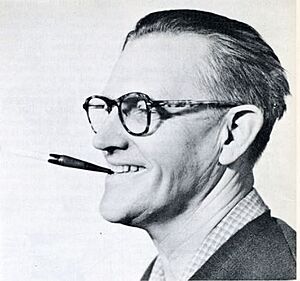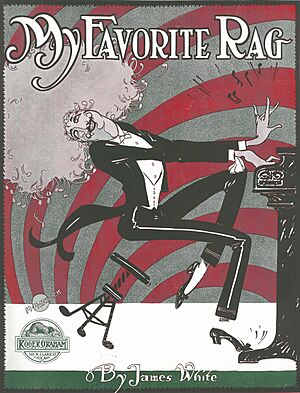Grim Natwick facts for kids
Quick facts for kids
Grim Natwick
|
|
|---|---|

Natwick, 1969
|
|
| Born |
Myron Nordveig
August 16, 1890 |
| Died | October 7, 1990 (aged 100) Los Angeles, California, U.S.
|
| Education | Academy of Fine Arts Vienna |
| Occupation |
|
| Spouse(s) |
Ida Wittenberg
(m. 1917; died 1925)Christine Ferris
(m. 1929; div. 1934) |
| Children | 1 |
| Relatives | Mildred Natwick (first cousin) |
| Awards | Inkpot Award (1978) |
| Signature | |
 |
|
Myron "Grim" Natwick (born Nordveig; August 16, 1890 – October 7, 1990) was a talented American artist, animator, and film director. He is most famous for creating the beloved cartoon character, Betty Boop, for Fleischer Studios.
Contents
Early Life and Education
Grim Natwick was born in Wisconsin Rapids, Wisconsin. He grew up with five brothers and two sisters. His parents, James and Henrietta, owned a furniture store.
Even before high school, Grim earned his nickname. It was a funny name because he was known for his cheerful personality, which was "anything but Grim"! He was very good at art and poetry, even when he was young. Many of his poems were shown at the South Wood County Historical Museum in Wisconsin Rapids.
Grim's brother, Frank, was also very talented. He was one of the first athletes from Wisconsin to be invited to the Olympics in 1908. Frank was a high hurdler for the University of Wisconsin–Madison.
After high school, Grim studied art at the School of the Art Institute of Chicago. Later, he continued his studies at the National Academy of Design.
Animation Career
Grim Natwick's art career began by designing covers for sheet music. He was good at it and soon illustrated many song sheets. These covers usually used only two colors.
A friend from school, Gregory La Cava, encouraged him to try animation. This was at the William Randolph Hearst Studio, which made cartoons based on their comic strips. Grim found that he enjoyed animation, and this new path lasted for about fifty years!
In 1925, after working at the studio for a year, Grim used his savings to travel. He sailed to the Vienna National Academy in Austria. There, he mostly drew human anatomy, especially women. He was inspired by famous artists like Egon Schiele and Gustav Klimt. He finished his studies in 1928 and moved back to New York.
Creating Betty Boop
Grim Natwick is best known for creating the popular character, Betty Boop. He designed Betty Boop at the request of Max Fleischer, the head of Fleischer Studios. Max wanted a girlfriend for his cartoon dog character, "Bimbo." Even though the studio owned Betty Boop, Grim created her original look. He was one of the main animators for Betty Boop, working on cartoons from Dizzy Dishes to Bimbo's Initiation.
Working with Disney and Other Studios
Grim Natwick worked for many different American animation studios. These included the Ub Iwerks studio, Walt Disney Animation Studios, Walter Lantz Productions, UPA, and the Richard Williams studio.
After seeing Grim's animation of Betty Boop, Walt Disney offered him a job. However, Grim chose to work at Ub Iwerks' studio first. He believed Iwerks was the true creative genius behind the Disney partnership at the time. At Iwerks' studio, Grim animated many Flip the Frog cartoons. He also designed the character Willie Whopper. Grim eventually helped run the studio's daily animation work.
In 1934, Grim Natwick joined Walt Disney Animation Studio. He was excited to work on the first full-length animated movie. His first job at Disney was animating the main female character in The Cookie Carnival. His skill in animating human characters was very important for Disney.
Animating Snow White
Grim Natwick became a lead animator for Disney's first feature film, Snow White and the Seven Dwarfs. He was mostly responsible for animating the main character, Snow White. He worked with some of the studio's best assistants, including Marc Davis.
Grim animated over 120 scenes for the movie. He was responsible for some of the most famous parts of the film. These include Snow White cleaning the house while singing "Whistle While You Work", her dancing with the dwarfs, and her singing "Someday My Prince Will Come".
Later Work and Legacy
In 1939, while working for Fleischer Studios again, Grim was in charge of drawing the Prince and Princess for Gulliver's Travels. He also helped animate other famous characters like Mickey Mouse in Fantasia, Mr. Magoo, Popeye, and Felix the Cat. Many animators who later became famous, like Walter Lantz, Chuck Jones, and Marc Davis, were once Grim's assistants.
In his later years, Grim Natwick also worked on commercials. He helped create the early images of Sonny, the "cuckoo" bird mascot for General Mills' Cocoa Puffs cereal.
Grim Natwick passed away on October 7, 1990, in Los Angeles, California. He was 100 years old.
In 2010, the Wisconsin Historical Society placed a special plaque in Wisconsin Rapids, Wisconsin, to honor Grim Natwick. The South Wood County Historical Museum in Wisconsin Rapids also has a large exhibit dedicated to his work.
Since 2010, the Grim Natwick Film Festival has been held every year in Wisconsin Rapids. It brings together animators from all over for panels and film screenings.
Grim Natwick's name even inspired a character in the 2017 video game Cuphead. This game has a cartoon style similar to the 1930s animation that Grim worked on. A dragon character in the game, named Grim Matchstick, has a similar way of speaking to Grim Natwick himself.
Partial Filmography (as animator)
Animators were often not given credit in early films. So, many of the films below might not list Grim Natwick's name, even though he worked on them. There might also be other films he worked on that are not yet known.
- 1993 The Thief and the Cobbler
- 1977 Raggedy Ann & Andy: A Musical Adventure
- 1963 The Mighty Hercules (TV series) (directing animator - 3 episodes; Double Trouble, Guarding of the Olympic Torch, & Medusa's Sceptre)
- 1960 Felix the Cat (TV series)
- 1959 "Terror Faces Magoo" (short)
- 1954 "Spare the Child" (short)
- 1951 "Georgie and the Dragon" (short)
- 1951 "Rooty Toot Toot" (short)
- 1950 "Bungled Bungalow" (short)
- 1950 "The Popcorn Story" (short)
- 1950 "Trouble Indemnity" (short)
- 1947 "The Bandmaster" (short)
- 1947 "Solid Ivory" (short)
- 1947 "Well Oiled" (short)
- 1947 "The Coo Coo Bird" (short)
- 1947 "Smoked Hams" (short)
- 1946 "The Wacky Weed" (short)
- 1946 "Fair Weather Fiends" (short)
- 1946 "The Reckless Driver" (short)
- 1946 "Bathing Buddies" (short)
- 1946 "Who's Cookin' Who?" (short)
- 1945 "The Dippy Diplomat" (short)
- 1945 "Chew-Chew Baby" (short)
- 1945 "Pied Piper of Basin Street" (short)
- 1945 "Enemy Bacteria" (short)
- 1944 "Ski for Two" (short)
- 1944 "Abou Ben Boogie" (short)
- 1943 "Take Heed Mr. Tojo" (short)
- 1940 "Popeye Presents Eugene, the Jeep" (short)
- 1940 "The Fulla Bluff Man" (short)
- 1939 Gulliver's Travels (animation director)
- 1938 "Mother Goose Goes Hollywood" (short)
- 1937 Snow White and the Seven Dwarfs
- 1936 "Little Boy Blue" (short)
- 1936 "Alpine Climbers" (short)
- 1936 "Dick Whittington's Cat" (short)
- 1936 "Ali Baba" (short)
- 1936 "Mickey's Polo Team" (short)
- 1935 "Broken Toys" (short)
- 1935 "Simple Simon" (short)
- 1935 "The Three Bears" (short)
- 1935 "Mickey's Fire Brigade" (short)
- 1935 "Sinbad the Sailor" (short)
- 1935 "Summertime" (short)
- 1935 "The Cookie Carnival" (short)
- 1935 "Old Mother Hubbard" (short)
- 1934 "The King's Tailor" (short)
- 1934 "Viva Willie" (short)
- 1934 "Aladdin and the Wonderful Lamp" (short)
- 1934 "Jungle Jitters" (short)
- 1934 "Cave Man" (short)
- 1934 "Reducing Creme" (short)
- 1934 "Insultin' the Sultan" (short)
- 1934 "Robin Hood, Jr." (short)
- 1933 "Jack and the Beanstalk" (short)
- 1933 "Soda Squirt" (short)
- 1932 "The Music Lesson"(short)
- 1932 "Phoney Express" (short)
- 1932 "The Goal Rush" (short)
- 1932 "Stormy Seas" (short)
- 1932 "Room Runners" (short)
- 1932 "The Office Boy" (short)
- 1932 "The Milkman" (short)
- 1931 "Africa Squeaks" (short)
- 1931 "Jail Birds" (short)
- 1931 "The New Car" (short)
- 1931 "Bimbo's Initiation" (short)
- 1931 "Silly Scandals" (short)
- 1931 "Ragtime Romeo" (short)
- 1931 "The Male Man" (short)
- 1931 "The Bum Bandit" (short)
- 1931 "Teacher's Pest" (short)
- 1931 "Tree Saps" (short)
- 1931 "Please Go 'Way and Let Me Sleep" (short)
- 1930 "Mysterious Mose" (short)
- 1930 "Accordion Joe" (short)
- 1930 "Mariutch" (short)
- 1930 "Swing You Sinners!" (short)
- 1930 "Barnacle Bill" (short)
- 1930 "Dizzy Dishes" (short)
- 1930 "Wise Flies" (short)
- 1930 "Fire Bugs" (short)
- 1930 "Hot Dog" (short)
- 1922 "A Joy Ride" (short)
- 1920 "Yes Dear" (short)
- 1919 "Breath of a Nation" (short)


